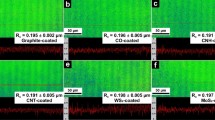Abstract
Addition of nanoparticles to liquid lubricants often leads to a reduction in both friction and wear rates for a wide range of solid–liquid–nanoparticle combinations. While the lubricating properties of nanoparticles are well documented, the detailed physical mechanisms remain to be fully explored. In a step toward such an understanding, the nano-tribological properties of gold surfaces immersed in aqueous suspensions of negatively charged SiO2 nanoparticles were examined by means of Quartz Crystal Microbalance (QCM) and Atomic Force Microscopy methods. The SiO2 nanoparticles were found to reduce the resistance to shear motion at the QCM’s solid–liquid interface. The effect was observed to be concentration dependent, with ca. 1.5 wt% yielding the maximum reduction in shear. An electrokinetic mechanism is proposed whereby the loosely bound nanoparticles roll and/or slide on the surface, while upper layers of nanoparticles slip over the surface layer because of the repulsive electrostatic forces between the individual particles. The nanoparticles were observed to remove the electrode material from the gold surface and slightly increase the overall roughness with the major change happening within the first hour of the exposure. This study inherently provides insight into a complex interface of solid, liquid and nanoparticles at a nanometer scale.






Similar content being viewed by others
References
Spikes, H.: Friction modifier additives. Tribol. Lett. (2015). doi:10.1007/s11249-015-0589-z
Dai, W., Kheireddin, B., Gao, H., Liang, H.: Roles of nanoparticles in oil lubrication. Tribol. Int. 102, 88–98 (2016)
Krim, J.: Friction and energy dissipation mechanisms in adsorbed molecules and molecularly thin films. Adv. Phys. 61(3), 155–323 (2012)
Liu, Z., Leininger, D., Koolivand, A., Smirnov, A.I., Shenderova, O., Brenner, D.W., Krim, J.: Tribological properties of nanodiamonds in aqueous suspensions: effect of the surface charge. RSC Adv. 5(96), 78933–78940 (2015)
Liu, X., Xu, N., Li, W., Zhang, M., Chen, L., Lou, W., Wang, X.: Exploring the effect of nanoparticle size on the tribological properties of SiO2/polyalkylene glycol nanofluid under different lubrication conditions. Tribol. Int. 109, 467–472 (2017)
Jiao, D., Zheng, S., Wang, Y., Guan, R., Cao, B.: The tribology properties of alumina/silica composite nanoparticles as lubricant additives. Appl. Surf. Sci. 257, 5720–5725 (2011)
Gorbunova, T.I., Zapevalov, A.Y., Beketov, I.V.: Preparation and antifrictional properties of surface modified hybrid fluorine-containing silica particles. Appl. Surf. Sci. 326, 19–26 (2015)
Bao, Y.Y., Sun, J.L., Kong, L.H.: Tribological properties and lubricating mechanism of SiO2 nanoparticles in water-based fluid. IOP Conf. Ser. Mater. Sci. Eng. 182(1), 012025 (2017)
Sorensen, C.M.: The mobility of fractal aggregates: a review. Aerosol Sci. Technol. 45(7), 765–779 (2011)
Stanford Research System: QCM 100 Quartz Crystal Microbalance Analog Controller—QCM 25 Crystal Oscillator. Stanford Research Systems Inc, California (2002)
Kanazawa, K.K., Gordon, J.G.: Frequency of a quartz microbalance in contact with liquid. Anal. Chem. Acta 175, 99–105 (1985)
Martin, S.J., Granstaff, V.E., Frye, G.C.: Characterization of a quartz crystal microbalance with simultaneous mass and liquid loading. Anal. Chem. 63, 2272–2281 (1991)
Martin, S.J., Frye, G.C., Ricco, A.J., Senturia, S.D.: Effects of surface roughness on the response of a thickness-shear mode resonator in liquids. Anal. Chem. 65, 2910–2922 (1993)
Urbakh, M., Daikhin, L.: Influence of the surface morphology on the quartz crystal microbalance response in a fluid. Langmuir 10(8), 2836–2841 (1994)
Daikhin, L., Gileadi, E., Katz, G., Tsionsky, V., Urbakh, M., Zagidulin, D.: Influence of roughness on the admittance of the quartz crystal microbalance immersed in liquids. Anal. Chem. 74(3), 554–561 (2002)
Acharya, B., Sidheswaran, M.A., Yungk, R., Krim, J.: Quartz crystal microbalance apparatus for study of viscous liquids at high temperatures. Rev. Sci. Instrum. 88(2), 025112 (2017)
Sauerbrey, G.: Verwendung von Schwingquarzen zur Wägung dünner Schichten und zur Mikrowägung. Z. Phys. A Hadrons Nucl. 155(2), 206–222 (1959)
Krim, J., Palasantzas, G.: Experimental observations of self-affine scaling and kinetic roughening at submicron lengthscales. Int. J. Mod. Phys. B 09, 599 (1995)
Krim, J., Heyvaert, I., Van Haesendonck, C., Bruynseraede, Y.: Scanning tunneling microscopy observation of self-affine fractal roughness in ion-bombarded film surfaces. Phys. Rev. Lett. 70(1), 57 (1993)
Palasantzas, G., Krim, J.: Scanning tunneling microscopy study of the thick film limit of kinetic roughening. Phys. Rev. Lett. 73(26), 3564 (1994)
Urbakh, M., Tsionsky, V., Gileadi, E., Daikhin, L.: Probing the solid/liquid interface with the quartz crystal microbalance. In: Steinem, C., Janshoff, A. (eds.) Piezoelectric Sensors, vol. 5, pp. 111–149. Springer, Berlin, Heidelberg (2006)
Lane, J.M.D., Ismail, A.E., Chandross, M., Lorenz, C.D., Grest, G.S.: Forces between functionalized silica nanoparticles in solution. Phys. Rev. E 79(5), 050501 (2009)
Dultsev, F.N., Kolosovsky, E.A.: QCM model as a system of two elastically bound weights. Sens Actuators B 242, 965–968 (2017)
Curtis, C.K., Krim, J.: Comparative study of the distinguishing characteristics of effective eco-friendly lubricants comprised of water-based nanodiamond suspensions. Submitted to Beilstein Journal of Nanotechnology (under review)
Jing, D., Pan, Y., Wang, X.: The effect of the electrical double layer on hydrodynamic lubrication: a non-monotonic trend with increasing zeta potential. Beilstein J. Nanotechnol. 8, 1515–1522 (2017). doi:10.3762/bjnano.8.152
Tucker, Z.: The performance of translucent silicon-oxide nanoparticle lubricant additives. Tribol. Lubr. Technol. 73(4), 32–34 (2017)
Schoch, R.B., Han, J., Renaud, P.: Transport phenomena in nanofluidics. Rev. Mod. Phys. 80(3), 839 (2008)
Bocquet, L., Barrat, J.L.: Flow boundary conditions from nano-to micro-scales. Soft Matter 3(6), 685–693 (2007)
Acknowledgements
This work was supported by National Science Foundation Award Number DMR1535082. SEM studies were performed at the Analytical Instrumentation Facility (AIF) at North Carolina State University, which is supported by the State of North Carolina and the National Science Foundation (Award Number ECCS-1542015). The AIF is a member of the North Carolina Research Triangle Nanotechnology Network (RTNN), a site in the National Nanotechnology Coordinated Infrastructure (NNCI).
Author information
Authors and Affiliations
Corresponding author
Rights and permissions
About this article
Cite this article
Acharya, B., Chestnut, M., Marek, A. et al. A Combined QCM and AFM Study Exploring the Nanoscale Lubrication Mechanism of Silica Nanoparticles in Aqueous Suspension. Tribol Lett 65, 115 (2017). https://doi.org/10.1007/s11249-017-0898-5
Received:
Accepted:
Published:
DOI: https://doi.org/10.1007/s11249-017-0898-5




